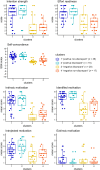Affective associations towards running: fuzzy patterns of implicit-explicit interaction in young female runners and non-runners
- PMID: 38356793
- PMCID: PMC10864672
- DOI: 10.3389/fspor.2024.1210546
Affective associations towards running: fuzzy patterns of implicit-explicit interaction in young female runners and non-runners
Abstract
Empirical evidence demonstrates that high concordance and low discrepancy of implicit and explicit affective processes facilitate consistent exercise behavior. Novice runners often have difficulties implementing their running behavior on a regular basis resulting in irregular running behavior. To investigate the potential value of affective associations 89 young female runners (regular and irregular) and non-runners were recruited. Affective associations towards running were measured through a Single-Target Implicit Association Test on the implicit level and by self-report on the explicit level. Implicit-explicit interaction (IEI) scores (i.e., implicit-explicit concordance and discrepancy) were derived from principal component analysis. Fuzzy k-means cluster analysis was used to identify patterns of interacting implicit-explicit affective associations. The resulting clusters were assessed for differences in previous running experience, current running behavior, motivational and intentional aspects. Four meaningful overlapping clusters were found and labeled according to their prevalent IEI patterns (i.e., "positive non-discrepant", "positive discrepant", "negative discrepant", "negative non-discrepant"). Significant differences between clusters were found for past running experience, current running behavior, motivational and intentional aspects. The results indicate that running behavior varies between and within patterns of affective associations. In line with previous findings, positive non-discrepant implicit and explicit affective associations are linked to more consistent running behavior, while negative non-discrepant affect is associated with non-runners. However, the occurrence of discrepant implicit-explicit affective associations in young women differing in running behavior, motivation, and intention broadens the view of the complex relationship between affective processes and exercise behavior. In conclusion, individualized interventions that take into account the implicit-explicit interaction of affective associations besides well-known cognitive self-regulatory resources may prove more effective for individuals who struggle to run regularly.
Keywords: affective associations; fuzzy cluster analysis; implicit-explicit interaction; running behavior; young women.
© 2024 Burberg, Würth, Amesberger and Finkenzeller.
Conflict of interest statement
The authors declare that the research was conducted in the absence of any commercial or financial relationships that could be construed as a potential conflict of interest.
Figures








Similar articles
-
To run or not to run? Differences in implicit attitudes towards running: An EEG study.Behav Brain Res. 2023 Oct 2;454:114637. doi: 10.1016/j.bbr.2023.114637. Epub 2023 Aug 28. Behav Brain Res. 2023. PMID: 37647993
-
Implicit and explicit affective associations towards cannabis use in patients with recent-onset schizophrenia and healthy controls.Psychol Med. 2010 Aug;40(8):1325-36. doi: 10.1017/S0033291709991814. Epub 2009 Nov 17. Psychol Med. 2010. PMID: 19917142
-
Does the discrepancy between implicit and explicit attitudes moderate the relationships between explicit attitude and (intention to) being physically active?BMC Psychol. 2019 Aug 7;7(1):52. doi: 10.1186/s40359-019-0322-z. BMC Psychol. 2019. PMID: 31391101 Free PMC article.
-
The Relationship of Explicit-Implicit Evaluative Discrepancy to Exercise Dropout in Middle-Aged Adults.J Sport Exerc Psychol. 2018 Apr 1;40(2):92-100. doi: 10.1123/jsep.2017-0267. Epub 2018 Jun 19. J Sport Exerc Psychol. 2018. PMID: 29914279
-
Explicit and Implicit Emotion Processing in the Cerebellum: A Meta-analysis and Systematic Review.Cerebellum. 2023 Oct;22(5):852-864. doi: 10.1007/s12311-022-01459-4. Epub 2022 Aug 23. Cerebellum. 2023. PMID: 35999332 Free PMC article.
References
-
- Mayo X, Liguori G, Iglesias-Soler E, Copeland RJ, Clavel San Emeterio I, Lowe A, et al. The active living gender’s gap challenge: 2013–2017 eurobarometers physical inactivity data show constant higher prevalence in women with No progress towards global reduction goals. BMC Public Health. (2019) 19(1):1677. 10.1186/s12889-019-8039-8 - DOI - PMC - PubMed
-
- Sheeran P, Webb TL. The intention-behavior gap. Soc Personal Psychol Compass. (2016) 10(9):503–18. 10.1111/spc3.12265 - DOI
LinkOut - more resources
Full Text Sources
Miscellaneous

